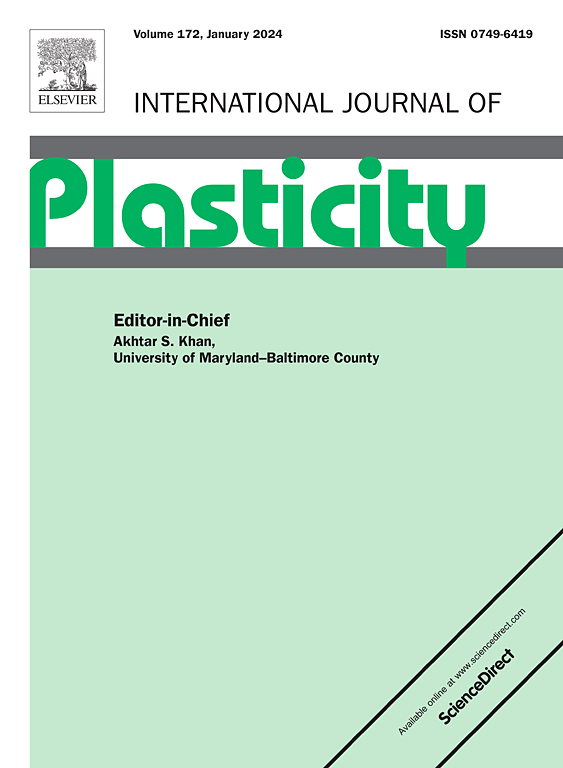通过Mn偏析引起的分层,显著提高了高强度钢从室温到低温的冲击韧性
IF 12.8
1区 材料科学
Q1 ENGINEERING, MECHANICAL
引用次数: 0
摘要
锰偏析是中/高锰钢不可避免的微观组织特征,通常会使力学性能恶化。本工作不是消除Mn偏析,而是首先通过人工引入Mn偏析带来引发分层增韧,开发出在常温和低温宽温度范围内冲击韧性明显提高的高强度中Mn钢。通过热轧和临界间退火相结合,获得了宽度为~ 7.6 μm的富mn细长奥氏体带和亚微米奥氏体/铁素体基体的异质结构。机械稳定性有限的粗奥氏体在变形时优先发生相变诱导塑性(TRIP)效应,形成具有丰富C/Mn含量的脆性TRIP-马氏体。这些与轧制方向平行的trip -马氏体作为脱层裂纹的起始点和扩展路径,在机械和微观结构上促进了脱层的激活,使脆性变为增韧。密集的贯穿厚度的分层裂纹的存在调节了主裂纹尖端周围的应力状态,通过形成新表面消耗能量,并激活了分层裂纹周围额外的TRIP效应。在~ -100°C时实现了明显的分层增韧,这得益于在低温下冲击韧性的异常增强。具有不同形态、尺寸和成分的奥氏体晶粒所提供的持续TRIP效应从本质上进一步提高了韧性。富锰带的形成进一步缓解了Mn向奥氏体晶界(pagb)的偏析,避免了通常在中锰钢中观察到的晶间断裂。这种新的增韧机制为开发在环境和低温下增强韧性的高强度材料铺平了道路。本文章由计算机程序翻译,如有差异,请以英文原文为准。


Significantly enhanced impact toughness from ambient to cryogenic temperature in high-strength steel via Mn segregation induced delamination
Mn segregation is an inevitable microstructural characteristic in medium/high Mn steels and generally deteriorates mechanical performance. Instead of eliminating Mn segregation, the present work firstly develops a high-strength medium Mn steel with obviously improved impact toughness at a wide temperature range between ambient and cryogenic temperatures by artificially introducing Mn segregated bands to initiate delamination toughening. By combining warm rolling and intercritical annealing, the heterostructure containing elongated Mn-rich austenite bands with a width of ∼7.6 μm and submicron austenite/ferrite matrix was realized. The coarse austenite bands featuring limited mechanical stability preferentially undergo transformation-induced plasticity (TRIP) effect upon deformation, inducing brittle TRIP-martensite with abundant C/Mn contents. These TRIP-martensite parallel to the rolling direction encourage the activation of delamination mechanically and microstructurally by serving as the initiation sites and propagation paths for delamination cracks, making brittleness into toughening. The presence of intensive through-thickness delamination cracks regulates the stress state around the main crack tip, consumes energy through the formation of new surfaces, and activates additional TRIP effects around delamination cracks. The pronounced delamination toughening was realized at ∼ -100 °C, benefiting from an abnormal enhancement of impact toughness at even low temperatures. The sustainable TRIP effect provided by austenite grains with distinct morphology, size, and composition further improves toughness intrinsically. Formation of Mn-rich bands furthermore relieves the segregation of Mn to prior austenite grain boundaries (PAGBs), avoiding intergranular fracture that is usually observed in medium Mn steel. This novel toughening mechanism paves the way for developing high-strength material with enhanced toughness at ambient and low temperatures.
求助全文
通过发布文献求助,成功后即可免费获取论文全文。
去求助
来源期刊

International Journal of Plasticity
工程技术-材料科学:综合
CiteScore
15.30
自引率
26.50%
发文量
256
审稿时长
46 days
期刊介绍:
International Journal of Plasticity aims to present original research encompassing all facets of plastic deformation, damage, and fracture behavior in both isotropic and anisotropic solids. This includes exploring the thermodynamics of plasticity and fracture, continuum theory, and macroscopic as well as microscopic phenomena.
Topics of interest span the plastic behavior of single crystals and polycrystalline metals, ceramics, rocks, soils, composites, nanocrystalline and microelectronics materials, shape memory alloys, ferroelectric ceramics, thin films, and polymers. Additionally, the journal covers plasticity aspects of failure and fracture mechanics. Contributions involving significant experimental, numerical, or theoretical advancements that enhance the understanding of the plastic behavior of solids are particularly valued. Papers addressing the modeling of finite nonlinear elastic deformation, bearing similarities to the modeling of plastic deformation, are also welcomed.
 求助内容:
求助内容: 应助结果提醒方式:
应助结果提醒方式:


